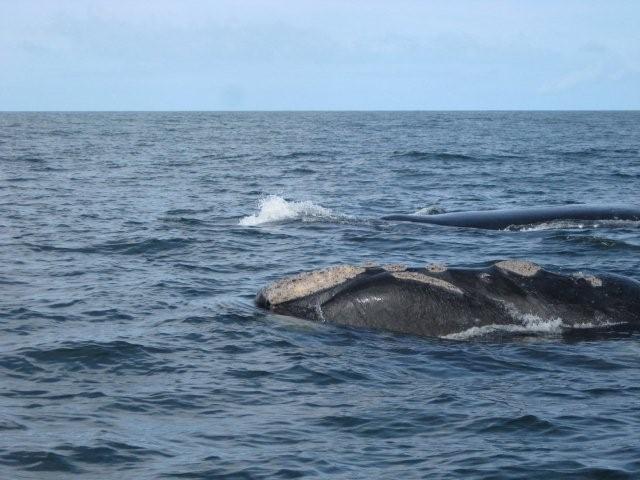|
Right whale facts
When we go through below whale facts, we understand better why whales inspire respect and admiration. They are simply magnificent and intelligent. It’s also so amazing to think that whales are mammals and so breathe air even though they are living in water! They actually breathe air at the surface of the water through 2 blowholes located near the top of the head. In Cape Town, Southern Right Whales are the most common and easy to differientiate from the others: they don't have a fin on their back and their backs are black with white dots. The other day, we were sitting on our terrace and for the first time of my life I saw a white whale. First, it was alone and we noticed that it was very small. Very quickly it was joined by a big whale who swam next to it. The day after, we read in the newspaper that it was actually a baby one which was sick and its mum helped him to swim to avoid it to sink.
BASIC WHALE FACTS Type: The biggest mammal that lives in water. Size: Northern right whale females grow to be about 50 feet (15.2 m) long, males are about 49 feet (15 m) long. Southern right whale females can grow up to 59 feet (18 m) long, males are about 50 feet (15.2 m) long. The females are slightly larger than males, as with all baleen whales. Weight: They can weigh up to 200,000 pounds (100 tons). Diet: Right whales (like all balleen whales) are seasonal feeders and sieve zooplankton, small fish, plankton and tiny crustaceans like copepods, krill and pteropods. They are skimmers, filter feeders that swim slowly with their mouth open on the surface, underwater and sometimes at the ocean’s bottom. The whales will go for large prey or prey with sufficient numbers. 38,000 litres of water can be ‘collected’ at each feeding mouthful of an adult whale! Average life cycle: around 60 years MORE DETAILED RIGHT WHALE FACTS Gestation: Reproduction and calving take place during the winter months. The right whale gestation period is about 1 year. The calf is born tail first and near the surface. It can weigh up to 1 ton and reach 20feet (6m) in length at birth! After a year, it can be as long as 40 feet (12m). Protection status: The northern right whale is one of the most endangered of cetaceans, numbering just over an estimated 500 animals. The southern right whales are more abundant with around 7,500 alive. Predators: Human hunted them. Now, lots of the Northern right whales die because of ship strikes and entanglement in fishing gear. Description: The right whale's body is usually black or very dark grey sometime with white or brown patches. Calves are blue to grey colour. They also have distinctive white callosities (roughened patches of skin containing barnacles and whale lice) on their heads. Right whales have a broad back with no dorsal fin and no throat grooves. They have large flippers. Their mouth starts above the eye. Right whales have between 200 and 270 long and fine baleen plates on each side of the mouth. Killer whales (Orca) are the fastest, swimming up to 30 miles per hour (48 kph) but right whales go much slower, reaching only 5 miles per hour (9.3 km/h) at full speed! Whale sounds: Right whale sounds are around 500 Hz. They belch, pop and groan to attract mates and keep track of offspring. It seems that right whale can hear the equivalent of police sirens and then move rapidly to the surface which can be useful to avoid ship whale collisions. Whale watching season: The best time to see them in Cape Town and around is from August to November when they migrate for breeding. Then, you have to look carefully because sometimes they can be very close to the coast. What ever distance separates you from her, you’ll never forget it! Right whales are highly acrobatic and frequently jump of the sea surface! I hope you learn about with these whale facts!
|





